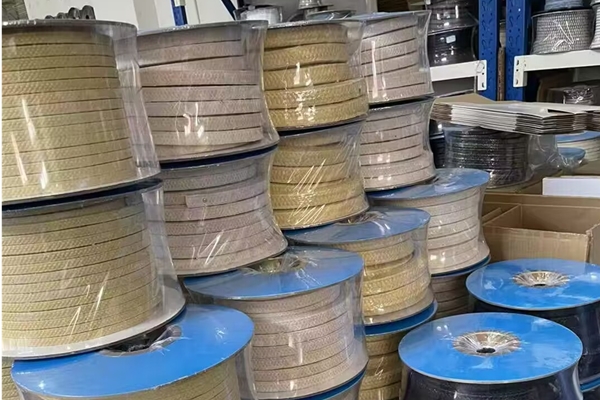Gland packing is one of the most commonly used sealing materials in pumps and valves. Typically, we cut the gland packing into rings, often with a 45-degree cut, and assemble it to form a seal. For higher sealing pressure, molded packing rings are recommended. This article will provide an in-depth guide on how to choose gland packing, the characteristics of different packing materials, and their working principles.
1. Factors to Consider When Choosing Gland Packing
Before selecting gland packing, several factors need to be considered, such as:
Temperature, pressure, and pH of the sealing medium
Speed of the equipment
Surface roughness, concentricity, radial runout, and eccentricity of the equipment
The selected packing material should meet the following requirements:
Elasticity and plasticity: The material should compensate for any sealing gaps.
Chemical stability: It should not degrade easily under different conditions.
Impermeability and self-lubrication: This prevents wear and tear on the rotating shaft.
Heat resistance: Capable of withstanding the heat generated by friction with the rotating shaft.
Easy installation and removal: It should be convenient for maintenance.
Simple manufacturing and low cost: The material should be economical.
2. Characteristics of Common Gland Packing Materials
Gland packing is made from a variety of materials, depending on the working conditions. Here are some of the most common types:
Natural Fiber Packing: Made from materials like cotton, hemp, and wool, suitable for lower temperatures and pressures.
Mineral Fiber Packing: Includes asbestos-based packing, known for its high heat resistance and corrosion resistance.
Synthetic Fiber Packing: Examples include graphite gland packing, carbon fiber packing, PTFE (polytetrafluoroethylene) gland packing, aramid fiber gland packing, and acrylic gland packing. These materials offer high resistance to temperature, pressure, and chemicals.
Ceramic and Metal Fiber Packing: Includes materials like silicon carbide packing, carbon fiber packing, ceramic fiber packing, and glass fiber packing, which are highly resistant to extreme temperatures and aggressive environments.
Other Advanced Materials: Nanofibers have become popular in recent years, offering superior sealing performance due to their innovative properties.
3. Gland Packing Manufacturing Techniques:
As manufacturing processes improve, so do the techniques for weaving gland packing. The conditions, environment, and weaving methods all have a direct impact on the sealing performance and lifespan of the packing. Common weaving methods include:
Braided Packing: This uses eight spindles to create a square cross-section. It provides good compensation for shaft vibration and eccentricity but has lower density and sealing performance for larger cross-sections.
Layered Braiding: Involves braiding multiple layers (1-4 layers) based on the required size. It offers high density and strong sealing performance, but layers may separate easily, making it more suitable for static seals or low-speed equipment.
Core-Spun Braiding: A rubber or metal core is wrapped with fiber in multiple layers. This method offers good density, strength, and flexibility, but the outer layer may wear out over time. It’s commonly used in pumps and valves.
Through-the-Heart Braiding: A more advanced technique, using multiple spindles to weave a square cross-section with high density and uniform contact with the shaft. It provides better sealing performance and a longer lifespan, suitable for high-speed rotating equipment.
4. Sealing Principles of Gland Packing
The sealing function of gland packing primarily relies on two effects: the labyrinth effect and the bearing effect.
Labyrinth Effect: When the packing contacts the shaft, the uneven surface of the shaft creates small gaps. These gaps act as a labyrinth, causing the pressurized medium to throttle multiple times as it passes through, thus achieving a sealing effect.
Bearing Effect: A thin film forms between the packing and the shaft, functioning like a sliding bearing. This provides lubrication, reducing friction and wear, thus extending the lifespan of the packing and the shaft.
5. Performance Indicators for Gland Packing Materials
The characteristics of the gland packing material directly affect its sealing performance and service life.
Here are some key performance indicators:
Compression Rate: The ratio of material thickness reduction when load is applied.
Resilience: The ability of the material to return to its original shape after the load is removed.
Wear Resistance: The degree of material degradation due to friction between surfaces.
Self-Lubrication: The material’s inherent lubricating properties, reduce friction.
Stress Relaxation Rate: The percentage of stress reduction under relaxation conditions.
Heat Loss: The percentage of material mass lost after being exposed to a specified temperature for a certain time.
Acid Loss: The percentage of mass loss after treatment with an acidic solution.
Alkali Loss: The percentage of mass loss after treatment with an alkaline solution.
Each gland packing material has specific industry or national standards to ensure quality. When choosing packing, users should consult professional resources and engineers to avoid potential failures or damages.
By understanding the working environment, packing materials, and manufacturing methods, the right gland packing can be selected to ensure optimal sealing performance and longevity in various industrial applications.




